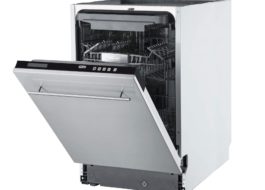Why doesn't my dishwasher dry my dishes?
 The final stage of the dishwasher program is drying. It is the drying that determines how beautiful the dishes will be when they come out. There are stains and drops on dishes that are not fully dried, and you feel embarrassed to put them on the holiday table. If the dishwasher does not dry, this indicates a problem that needs to be dealt with without leaving everything to chance. Let's figure out why the machine may not dry the dishes and how to fix this problem.
The final stage of the dishwasher program is drying. It is the drying that determines how beautiful the dishes will be when they come out. There are stains and drops on dishes that are not fully dried, and you feel embarrassed to put them on the holiday table. If the dishwasher does not dry, this indicates a problem that needs to be dealt with without leaving everything to chance. Let's figure out why the machine may not dry the dishes and how to fix this problem.
Causes of malfunction
If, when you open the dishwasher door, you see clean but damp dishes, then do not rush to think that the machine is broken. Most likely, the reason for poor drying of dishes is the type of drying. Most dishwashers have a condensation drying type, which is the cheapest and easiest. This type of drying is also called natural drying. However, condensation drying is not ideal.
The principle of its operation is to evaporate moisture from hot dishes. However, metal objects cool down at the same time as the walls of the tank, which causes condensation to form, which cannot be done about.
For your information! To improve drying, some dishwasher users advise opening the machine door slightly after the end of the program, and also not leaving dishes for a long time so that condensation does not have time to settle.
If the dishes are not only wet, but also poorly washed, then in this case you should think about a serious malfunction.
In machines with condensation drying, this can be:
- breakdown of the heating element, as a result of which the water does not heat up, and therefore the dishes are not washed or dried;
- The temperature sensor is faulty;
- relay failure on the control module.
In the case of dishwashers with turbo dryers, another cause of failure may be the failure of the fan that blows hot air into the chamber with dishes; the result is that the machine does not dry the dishes. Let's now figure out how to fix these problems.
Broken heating element and temperature sensor
If the heating element and temperature sensor fail, only complete replacement of the elements is possible. Diagnosing a broken heating element in general is not difficult; this will require skills in working with a multimeter. In most dishwasher models, including Bosch, the heating element is flow-through and is located in the lower part. In order to get it out you will have to turn the car over and remove the bottom part. Next is the heating element, checked for functionality and, if necessary, replaced with a new one, preferably original. The whole process is described in more detail in the article. Replacing heating element in a dishwasher.
As for the temperature sensor, in working condition it regulates the operation of the heating element, giving a command to dry the dishes. If the sensor fails, then the heating element does not receive a command, drying does not begin, and in some cases the process stops even at the stage of washing the dishes. The temperature sensor is located in the opening of the chamber designed to collect water. In some dishwasher models, the same chamber may also contain a water purity sensor. The wires are removed from the temperature sensor, and then the sensor itself is taken out. A new sensor is installed in place of the old one and the repair will be completed; all that remains is to assemble the car and test it.

For your information! In LG dishwashers, the temperature sensor is located at the base of the heating element, just like in washing machines.
Fan and relay are faulty
One of the common reasons that a dishwasher does not dry dishes is a faulty relay located on the control board. In most cases (in fully built-in or free-standing machines), the control board is located inside the door, which can be easily disassembled by unscrewing a few bolts.
Having taken out the control board, you will see a relay on it, replacing which will require some skill when working with a soldering iron. If you doubt that you can cope with such work, it is better to contact a specialist who will do everything for sure. Replacing a relay is an inexpensive repair.
As for the fan in machines with a turbo dryer, if it breaks down it also needs to be changed, it can be repaired  is not subject to. When the fan stops working, you will not hear the characteristic sound when the turbo dryer is operating. The fan that pumps hot air is located differently in different machine models, mainly on the side wall, in Bosch models in the lower part of the chamber, and in AEG machines, on the contrary, in the upper part. Therefore, to get to it, you will have to disassemble almost the entire dishwasher. To avoid this, you can entrust the work to a specialist, which will cost about $20, plus the cost of the fan itself.
is not subject to. When the fan stops working, you will not hear the characteristic sound when the turbo dryer is operating. The fan that pumps hot air is located differently in different machine models, mainly on the side wall, in Bosch models in the lower part of the chamber, and in AEG machines, on the contrary, in the upper part. Therefore, to get to it, you will have to disassemble almost the entire dishwasher. To avoid this, you can entrust the work to a specialist, which will cost about $20, plus the cost of the fan itself.
Thus, there may be several reasons why a dishwasher does not dry dishes well or does not dry them at all. All of them are easily removable and do not cause any special problems, good luck with your repair!
Interesting:
Reader comments
- Share your opinion - leave a comment
Categories
Washing machine repair


For buyers

For users

Dishwasher

















Add a comment